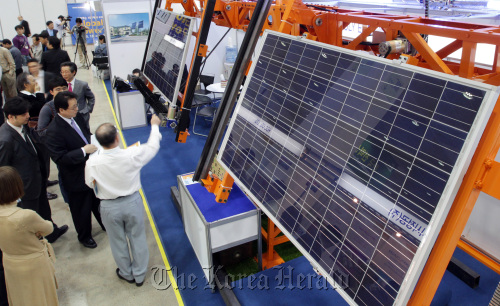Samsung SDI, LG Chem, Hanwha participate in solar power projects
An increasing number of firms are betting on solar energy projects as solar power is figured to be one of the fastest-rising new growth engines in the country.
Large businesses, such as Samsung SDI, LG Chemical, Hanwha and SK subsidiary SKC, are gearing up to increase production to prepare for the rising demand for solar energy.
According to a recent report published by the Korea Photovoltaic Industry Association, this year’s total sales of solar energy-related products from manufacturers is expected to surge to 10.42 trillion won ($9.68 billion), up from 5.9 trillion won reached last year.
Industrial sales have been increasing year-on-year from 440 billion won in 2007 and 1.54 trillion won in 2008 to 2.37 trillion won in 2009, it said.
An increasing number of firms are betting on solar energy projects as solar power is figured to be one of the fastest-rising new growth engines in the country.
Large businesses, such as Samsung SDI, LG Chemical, Hanwha and SK subsidiary SKC, are gearing up to increase production to prepare for the rising demand for solar energy.
According to a recent report published by the Korea Photovoltaic Industry Association, this year’s total sales of solar energy-related products from manufacturers is expected to surge to 10.42 trillion won ($9.68 billion), up from 5.9 trillion won reached last year.
Industrial sales have been increasing year-on-year from 440 billion won in 2007 and 1.54 trillion won in 2008 to 2.37 trillion won in 2009, it said.

Larger production and bigger investments are being allocated to solar power projects because the markets for semiconductor and liquid crystal display projects are now considered to have matured, industry sources say.
“We’re planning to break the ground for the polysilicon plant by early next year in Yeosu, South Jeolla Province, to have the plant fully running by the latter half of 2013,” said an official at Hanwha Group.
The move comes in line with Hanwha Chemical’s plan announced earlier in April to invest 1 trillion won to enter the polysilicon manufacturing market. Polysilicon is a material used in solar cells.
Its rival LG Chemical, the country’s largest chemicals maker, also said last week that it will spend 491 billion won to construct its first polysilicon plant in Yeosu.
The facility, which is to be completed by the end of 2013, is expected to produce 5,000 metric tons of polysilicon per year, it said.
Kim Bahn-suk, the chief executive of LG Chem, told investors in April that the firm, equipped with its own technologies, was moving into the polysilicon market for it was confident that it could beat competitors with its low cost advantage.
OCI Co., Woongjin Polysilicon Co., Hankook Silicon Co. and KCC Corp. are already operating polysilicon plants in Korea.
Samsung SDI, in the meantime, also vowed last week to become a global energy firm as it took over solar battery businesses from its sister firm Samsung Electronics.
Solar batteries were among the five areas picked by Samsung owner Lee Kun-hee to foster for new revenue sources.
“Our goal is to become the world’s top company in both electric and solar batteries, and we will be certain to demonstrate the plausibility of this objective within the next three to five years,” said its CEO Park Sang-jin.
Setting its annual revenue target at 13 trillion won in sales in 2015, more than half of the sales are to come from its battery unit, said Park.
Samsung SDI used to play the role of a display maker, but began developing lithium ion batteries to shift focus to renewable energy in 2000.
“Even with concerns that the active participation of firms in solar projects may create an oversupply, large sums are being invested since price competitiveness and technological skills associated with the solar power-related products are thought to overcome it,” said an official at the Korea Photovoltaic Industry Association. “But we must put more effort into improving product competitiveness because China is also making massive investments in the solar power industry.”
By Cho Ji-hyun (sharon@heraldcorp.com)





![[Herald Interview] 'Amid aging population, Korea to invite more young professionals from overseas'](http://res.heraldm.com/phpwas/restmb_idxmake.php?idx=644&simg=/content/image/2024/04/24/20240424050844_0.jpg&u=20240424200058)











![[KH Explains] Korean shipbuilding stocks rally: Real growth or bubble?](http://res.heraldm.com/phpwas/restmb_idxmake.php?idx=652&simg=/content/image/2024/04/25/20240425050656_0.jpg&u=)

